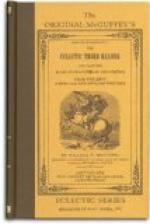NEW YORK-CHICH
ESTER-WEINHEIM-BRISBANE-SINGAPORE-TORONTO
Preface. In revising this book, care has been taken to preserve all the excellences that have so long and so favorably distinguished McGUFFEY’S Eclectic spelling-book: and the chief changes that have been made, have been suggested by the evident plan of the original work.
The old system of indicating the pronunciation by numerals, called “superiors,” has been abandoned, and the diacritical marks used by Webster have been adopted. The Revised Speller conforms in orthography, pronunciation, and syllabication to the latest edition of Webster’s Unabridged Dictionary. Exercises have been given on each of the distinctive marks used in the book, as will be seen by reference to Lessons 36-57.
A number of lessons have been added in the department of prefixes and suffixes, and now nearly all the more common of these etymological principles have been explained. (See Lessons 136-167.) In arranging the text of the several lessons, the object has been not to appeal merely to arbitrary memory, but to associate each lesson with some principle of sound, meaning, or accent, which would tend to aid the pupil in acquiring a knowledge of our language. Several distinct lessons on pronunciation are given, and towards the close of the book numerous lessons of difficult words in orthography have been introduced.
Instead of indicating silent letters by italics, as has hitherto been done, a new type has been made in which such letters are canceled, thus enabling the pupil to discover their status at a glance.
The pages have been enlivened, as in the other books of this Series, by attractive engravings.
The publishers take pleasure in acknowledging the valuable services of W. B. Watkins, D. D., who planned and executed this revision. December, 1879.
16
Copyright, 1879, by Van Antwerp, Bragg & Co.
THE ENGLISH ALPHABET.
The English Alphabet consists of twenty-six letters,
viz.: a,b,c,d,e,f,g,h,i,j,k,l,m,n,o,p,q,r,s,t,u
,v,w,x,y,z.
Letters are divided into vowels and consonants.
The Vowels are those letters which can be perfectly sounded without the aid of any other letter. The vowels are a, e, i, o, u, w, and y.
The vowel sounds of w and y are the same as those of u and i. A, e, and o are always vowels. I, u, w, and y are sometimes consonants.
A Diphthong is the union of two vowels in one sound. When both vowels are sounded, the diphthong is called proper, because then it is really a diphthong, or double sound; that is, the sounds of the vowels unite; as, oi in oil; ou in sound.
When only one of the vowels is sounded, the diphthong is called improper, because then, as one of the vowels is silent, it is not properly a diphthong, though it takes that name; as, oa in boat, ui in suit, where a and i are silent.




